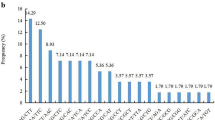Abstract
Inter-simple sequence repeat (ISSR) amplification was used to analyze microsatellite motif frequency in the rice genome and to evaluate genetic diversity among rice cultivars. A total of 32 primers, containing different simple sequence repeat (SSR) motifs, were tested for amplification on a panel of 59 varieties, representative of the diversity of cultivated rice (Oryza sativa L.). The ISSR analysis provided insights into the organization, frequency and levels of polymorphism of different simple sequence repeats in rice. The more common dinucleotide motifs were more amenable to ISSR analysis than the more infrequent tri-, tetra- and penta-nucleotide motifs. The ISSR results suggested that within the dinucleotide class, the poly(GA) motif was more common than the poly(GT) motif and that the frequency and clustering of specific tri- and tetra-nucleotide simple sequence repeats was variable and motif-specific. Furthermore, trinucleotide ISSR markers were found to be less polymorphic than either dinucleotide or certain tetranucleotide ISSR markers, suggesting which motifs would be better targets for microsatellite marker development. The ISSR amplification pattern was used to group the rice genotypes by cluster analysis. These results were compared to surveys of the same varieties for amplified fragment length polymorphism (AFLP), restriction fragment length polymorphism (RFLP) and isozyme markers. The ISSR fingerprint could be used to differentiate the genotypes belonging to either Japonica or Indica sub species of cultivated rice and to dissect finer levels of diversity within each subspecies. A higher percentage of polymorphic bands was produced with the ISSR technique than the AFLP method, based on a similar PCR reaction. Therefore, ISSR amplification proved to be a valuable method for determining genetic variability among rice varieties and for rapidly identifying cultivars. This efficient genetic fingerprinting technique would be useful for characterizing the large numbers of rice accessions held in national and international germplasm centers.
Similar content being viewed by others
Author information
Authors and Affiliations
Additional information
Received: 25 May 1998 / Accepted: 17 September 1998
Rights and permissions
About this article
Cite this article
Blair, M., Panaud, O. & McCouch, S. Inter-simple sequence repeat (ISSR) amplification for analysis of microsatellite motif frequency and fingerprinting in rice (Oryza sativa L.). Theor Appl Genet 98, 780–792 (1999). https://doi.org/10.1007/s001220051135
Issue Date:
DOI: https://doi.org/10.1007/s001220051135




